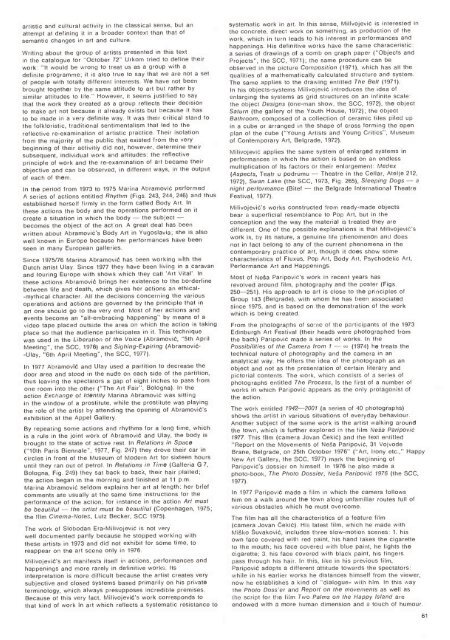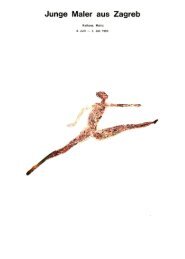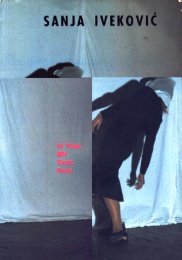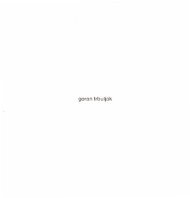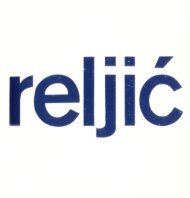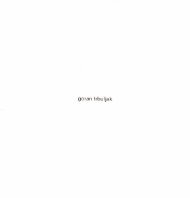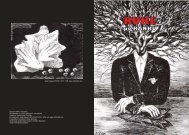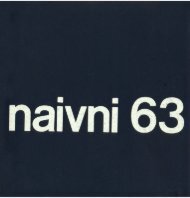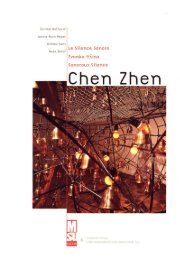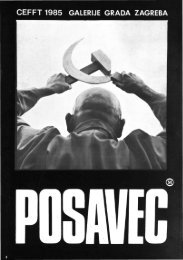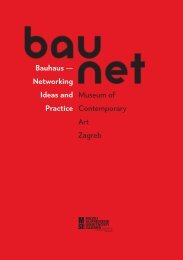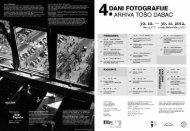The New Art Practice in Yugoslavia, 1966-1978
The New Art Practice in Yugoslavia, 1966-1978
The New Art Practice in Yugoslavia, 1966-1978
- TAGS
- practice
- yugoslavia
- www.msu.hr
Create successful ePaper yourself
Turn your PDF publications into a flip-book with our unique Google optimized e-Paper software.
artistic and cultural activity <strong>in</strong> the classical sense, but an<br />
attempt at def<strong>in</strong><strong>in</strong>g it <strong>in</strong> a broader context than that of<br />
semantic changes <strong>in</strong> art and culture.<br />
Writ<strong>in</strong>g about the group of artists presented <strong>in</strong> this text<br />
<strong>in</strong> the catalogue for "October 72" Urkom tried to def<strong>in</strong>e their<br />
work: "It would be wrong to treat us as a group with a<br />
def<strong>in</strong>ite programme: it is also true to say that we are not a set<br />
of people with totally different <strong>in</strong>terests. We have not been<br />
brought together by the same attitude to art but rather by<br />
similar attitudes to life." However, it seems justified to say<br />
that the work they created as a group reflects their decision<br />
to make art not because it already exists but because it has<br />
to be made <strong>in</strong> a very def<strong>in</strong>ite way. It was their critical stand to<br />
the folkloristic, traditional sentimentalism that led to the<br />
reflective re-exam<strong>in</strong>ation of artistic practice. <strong>The</strong>ir isolation<br />
from the majority of the public that existed from the very<br />
beg<strong>in</strong>n<strong>in</strong>g of their activitiy did not, however, determ<strong>in</strong>e their<br />
subsequent, <strong>in</strong>dividual work and attitudes: the reflective<br />
pr<strong>in</strong>ciple of work and the re-exam<strong>in</strong>ation of art became their<br />
objective and can be observed, <strong>in</strong> different ways, <strong>in</strong> the output<br />
of each of them.<br />
In the period from 1973 to 1975 Mar<strong>in</strong>a Abramovi performed<br />
A series of actions entitled Rhythm (Figs. 243, 244, 246) and thus<br />
established herself firmly <strong>in</strong> the form called Body <strong>Art</strong>. In<br />
these actions the body and the operations performed on it<br />
create a situation <strong>in</strong> which the body the subject<br />
becomes the object of the acton A great deal has been<br />
written about Abramovi's Body <strong>Art</strong> <strong>in</strong> <strong>Yugoslavia</strong>: she is also<br />
well known <strong>in</strong> Europe because her performances have been<br />
seen <strong>in</strong> many European galleries.<br />
S<strong>in</strong>ce 1975/76 Mar<strong>in</strong>a Abramovi has been work<strong>in</strong>g with the<br />
Dutch artist Ulay. S<strong>in</strong>ce 1977 they have been liv<strong>in</strong>g <strong>in</strong> a caravan<br />
and tour<strong>in</strong>g Europe with shows which they call '<strong>Art</strong> Vital'. In<br />
these actions Abramovi br<strong>in</strong>gs her existence to the borderl<strong>in</strong>e<br />
between life and death, which gives her actions an ethical-<br />
-mythical character. All the decisions concern<strong>in</strong>g the various<br />
operations and actions are governed by the pr<strong>in</strong>ciple that <strong>in</strong><br />
art one should go to the very end. Most of her actions and<br />
events become an "all-embrac<strong>in</strong>g happen<strong>in</strong>g" by means of a<br />
video tape placed outside the area on which the action is tak<strong>in</strong>g<br />
place so that the audience participates <strong>in</strong> it. This technique<br />
was used <strong>in</strong> the Liberation of the Voice (Abramovi, "5th April<br />
Meet<strong>in</strong>g", the SCC, 1976) and Sigh<strong>in</strong>g-Expir<strong>in</strong>g (Abramovi-<br />
-Ulay, "6th April Meet<strong>in</strong>g", the SCC, 1977).<br />
In 1977 Abramovi and Ulay used a partition to decrease the<br />
door area and stood <strong>in</strong> the nude on each side of the partition,<br />
thus leav<strong>in</strong>g the spectators a gap of eight <strong>in</strong>ches to pass from<br />
one room <strong>in</strong>to the other ("<strong>The</strong> <strong>Art</strong> Fair", Bologna). In the<br />
action Exchange of Identity Mar<strong>in</strong>a Abramovi was sitt<strong>in</strong>g<br />
<strong>in</strong> the w<strong>in</strong>dow of a prostitute, while the prostitute was play<strong>in</strong>g<br />
the role of the artist by attend<strong>in</strong>g the open<strong>in</strong>g of Abramovi's<br />
exhibition at the Appel Gallery.<br />
By repeat<strong>in</strong>g some actions and rhythms for a long time, which<br />
is a rule <strong>in</strong> the jo<strong>in</strong>t work of Abramovi and Ulay, the body is<br />
brought to the state of active rest. In Relations <strong>in</strong> Space<br />
("10th Paris Biennale", 1977, Fig. 247) they drove their car <strong>in</strong><br />
circles <strong>in</strong> front of the Museum of Modern <strong>Art</strong> for sixteen hours<br />
until they ran out of petrol. In Relations <strong>in</strong> Time (Galleria G 7,<br />
Bologna, Fig. 249) they sat back to back, their hair plaited;<br />
the action began <strong>in</strong> the morn<strong>in</strong>g and f<strong>in</strong>ished at 11 p.m.<br />
Mar<strong>in</strong>a Abramovi seldom expla<strong>in</strong>s her art at length: her brief<br />
comments are usually at the same time <strong>in</strong>structions for the<br />
performance of the action; for <strong>in</strong>stance <strong>in</strong> the action <strong>Art</strong> must<br />
be beautiful the artist must be beautiful (Copenhagen, 1975;<br />
the film C<strong>in</strong>ema-Notes. Lutz Becker, SCC 1975).<br />
<strong>The</strong> work of Slobodan Era-Milivojevi is not very<br />
well documented partly because he stopped work<strong>in</strong>g with<br />
these artists <strong>in</strong> 1973 and did not exhibit for some time, to<br />
reappear on the art scene only <strong>in</strong> 1976.<br />
Milivojevi's art manifests itself <strong>in</strong> actions, performances and<br />
happen<strong>in</strong>gs and more rarely <strong>in</strong> def<strong>in</strong>itive works. Its<br />
<strong>in</strong>terpretation is more difficult because the artist creates very<br />
subjective and closed systems based primarily on his private<br />
term<strong>in</strong>ology, which always presupposes <strong>in</strong>credible premises.<br />
Because of this very fact, Milivojevi's work corresponds to<br />
that k<strong>in</strong>d of work <strong>in</strong> art which reflects a systematic resistance to<br />
systematic work <strong>in</strong> art. In this sense, Milivojevi is <strong>in</strong>terested <strong>in</strong><br />
the concrete, direct work on someth<strong>in</strong>g, as production of the<br />
work, which <strong>in</strong> turn leads to his <strong>in</strong>terest <strong>in</strong> performances and<br />
happen<strong>in</strong>gs. His def<strong>in</strong>itive works have the same characeristic:<br />
a series of draw<strong>in</strong>gs of a comb on graph paper ("Objects and<br />
Projects", the SCC. 1971); the same procedure can be<br />
observed <strong>in</strong> the picture Composition (1971), which has all the<br />
qualities of a mathematically calculated structure and system.<br />
<strong>The</strong> same applies to the draw<strong>in</strong>g entitled <strong>The</strong> Belt (1971).<br />
In his objects-systems Milivojevi <strong>in</strong>troduces the idea of<br />
enlarg<strong>in</strong>g the systems as grid structures on an <strong>in</strong>f<strong>in</strong>ite scale:<br />
the object Designs (one-man show, the SCC, 1972), the object<br />
Saturn (the gallery of the Youth House, 1972); the object<br />
Bathroom, composed of a collection of ceramic tiles piled up<br />
<strong>in</strong> a cube or arranged <strong>in</strong> the shape of cross form<strong>in</strong>g the open<br />
plan of the cube ("Young <strong>Art</strong>ists and Young Critics", Museum<br />
of Contemporary <strong>Art</strong>, Belgrade, 1972).<br />
Milivojevi applies the same system of enlarged systems <strong>in</strong><br />
performances <strong>in</strong> which the action is based on an endless<br />
multiplication of its factors or their enlargement: Medex<br />
(Aspects, Teatr u podrumu <strong>The</strong>atre <strong>in</strong> the Cellar, Atelje 212,<br />
1972), Swan Lake (the SCC, 1973, Fig. 265), Sleep<strong>in</strong>g Dogs a<br />
night performance (Bitef the Belgrade International <strong>The</strong>atre<br />
Festival, 1977).<br />
Milivojevi's works constructed from ready-made objects<br />
bear a superficial resemblance to Pop <strong>Art</strong>, but <strong>in</strong> the<br />
conception and the way the material is treated they are<br />
different. One of the possible explanations is that Milivojevi's<br />
work is, by its nature, a genu<strong>in</strong>e life phenomenon and does<br />
not <strong>in</strong> fact belong to any of the current phenomena <strong>in</strong> the<br />
contemporary practice of art, though it does show some<br />
characteristics of Fluxus, Pop <strong>Art</strong>, Body <strong>Art</strong>, Psychedelic <strong>Art</strong>,<br />
Performance <strong>Art</strong> and Happen<strong>in</strong>gs.<br />
Most of Nea Paripovi's work <strong>in</strong> recent years has<br />
revolved around film, photography and the poster (Figs.<br />
250-251). His approach to art is close to the pr<strong>in</strong>ciples of<br />
Group 143 (Belgrade). with whom he has been associated<br />
s<strong>in</strong>ce 1975, and is based on the demonstration of the work<br />
which is be<strong>in</strong>g created.<br />
From the photographs of cone of the participants of the 1973<br />
Ed<strong>in</strong>burgh <strong>Art</strong> Festival (their heads were photographed from<br />
the back) Paripovi made a series of works. In the<br />
Possibilities of the Camera from 1 .0 (1974) he treats the<br />
technical nature of photography and the camera <strong>in</strong> an<br />
analytical way. He offers the idea of the photograph as an<br />
object and not as the presentation of certa<strong>in</strong> literary and<br />
pictorial contents. <strong>The</strong> work, which consEsts of a series of<br />
photographs entitled <strong>The</strong> Process, is the first of a number of<br />
works <strong>in</strong> which Paripovi appears as the only protagonist of<br />
the action.<br />
<strong>The</strong> work entitled 1942-2001 (a series of 40 photographs)<br />
shows the artist <strong>in</strong> various situations of everyday behaviour.<br />
Another subject of the same work is the artist walk<strong>in</strong>g around<br />
the town, which is further explored <strong>in</strong> the film Nea Paripovi<br />
1977. This film (camera Jovan eki) and the text entitled<br />
"Report on the Movements of Nea Paripovi, 31 Vojvode<br />
Brane, Belgrade, on 25th October 1976" ("<strong>Art</strong>. Irony etc.," Happy<br />
<strong>New</strong> <strong>Art</strong> Gallery, the SCC, 1977) mark the beg<strong>in</strong>n<strong>in</strong>g of<br />
Paripovi's dossier on himself. In 1976 he also made a<br />
photo-book, <strong>The</strong> Photo Dossier, Nose Paripovi 1976 (the SCC,<br />
1977).<br />
In 1977 Paripovi made a film <strong>in</strong> which the camera follows<br />
him on a walk around the town along unfamiliar routes full of<br />
various obstacles which he must overcome.<br />
<strong>The</strong> film has all the characteristics of a feature film<br />
(camera Jovan eki). His latest film, which he made with<br />
Miko uvakovi, <strong>in</strong>cludes three slow-motion scenes: 1. his<br />
own face covered with red pa<strong>in</strong>t, his hand takes the cigarette<br />
to the mouth; his face covered with blue pa<strong>in</strong>t, he lights the<br />
cigarette: 3. his face covered with black pa<strong>in</strong>t, his f<strong>in</strong>gers<br />
pass through his hair. In this, like <strong>in</strong> his previous film,<br />
Paripovi adopts a different attitude towards the spectators:<br />
while <strong>in</strong> his earlier works he distances himself from the viewer,<br />
now he establishes a k<strong>in</strong>d of "dialogue', with him. In this way<br />
the Photo Doss.er and Report on the movements as well as<br />
the script for the film Two Palms on the Happy Island are<br />
endowed with a more human dimension and a touch of humour.<br />
61


